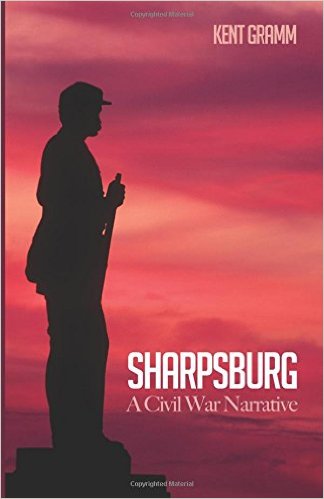Sharpsburg: A Civil War Narrative by Kent Gramm. Resource Publications, 2015. Paper, ISBN: 978-1-4982-3906-6. $17.00.
 Strong ground can make all the difference in battle. Military men know it, and writers do, too. Consider Daniel Harvey Hill, “his men all alone, the way he wanted,/on South Mountain,” or Lee, who “looked at the high/ground behind Antietam Creek at Sharpsburg,/and said, ‘We will make our stand on those hills. . . .”
Strong ground can make all the difference in battle. Military men know it, and writers do, too. Consider Daniel Harvey Hill, “his men all alone, the way he wanted,/on South Mountain,” or Lee, who “looked at the high/ground behind Antietam Creek at Sharpsburg,/and said, ‘We will make our stand on those hills. . . .”
But Kent Gramm, writing of these men, takes just the opposite approach in his new book, Sharpsburg: A Civil War Narrative. Starting with the title itself, the book opens with a series of references and frames that shift the ground beneath the reader’s feet. In doing so, Gramm creates a landscape well suited for his literary purposes.
“Sharpsburg” suggests a Southern-leaning perspective on the war’s bloodiest day. The book’s epigraph then evokes World War I, more closely associated with the war in 1864 and onward, not the early Civil War. Gramm immediately follows that with a note to readers that shifts perspective yet twice more: “In the summer of 2015, the Confederate battle flag came down from the South Carolina state capitol; but in the late summer of 1862 it flew higher than it ever had or ever would again.”
His subtitle even makes readers complicit in the shell game. Any writer who puts “Civil War” and “Narrative” in their title risks saddling themselves with the specter of Shelby Foote. Any reader subconsciously cued to that, however, quickly finds Gramm’s slim volume to be the graceful antithesis of Foote’s literary Maximalism, although it’s as beautifully written and thoughtful. Better, Gramm’s writing is far more accessible.
These subtle but complex shifts allow Gramm to approach Sharpsburg on his own terms. This is vitally important for a battle that has had so much ink spilled over it. While its meanings are still vigorously debated, the battle’s outcome is not; therefore, with little new information to convey, the value must be in the conveyance itself.
Gramm chooses to present his narrative as an extended poem told from the perspectives of a Southern soldier and a Northern soldier, speaking for “rebellion and equality.” While the book alternates between them, the Southern voice gets about twenty percent more time, perhaps justifying the title’s Southern lean.
The Southern voice doesn’t feel particularly “Southern” in average education level or colloquialism, but it is spot-on as an archetypical amalgam of attitude and motivation. This isn’t one soldier from one geographic location so much as a voice that manages to cover a wide variety of Southern perspectives, offering them up as musings for the reader to mull over.
Consider part of his commentary on Stonewall Jackson: “After he was gone, the war stopping going/well, is the plain fact,” Gramm’s Southern voice says, “a plain fact that could/tell two different truths—one that he was missed, or/that all those men he spent were missed.” Gramm’s Southerner never tips his own hand on such points, giving the author tremendous flexibility in exploring ideas—and inviting readers to consider them along with him.
Gramm’s greatest success is in capturing the Southern sense of romance without ever veering into moonlight and magnolias. “[A] Southerner is hardly better than/a damnyankee if he cannot exaggerate with honor,” Gramm’s Southerner proclaims.
The Southern sections are written in un-rhyming, ten-syllable lines. They amble without rambling, the way a country lane might wind through the Southern countryside.
Union sections are written in pentameter, but Gramm groups them into ten-line stanzas. The stanzas themselves often have rhyme schemes, although those rhymes vary from stanza to stanza. This gives the Union sections a more formal overall structure (like the Union army itself), while allowing for distinctive personality on a smaller scale (like the regiments within the army).
The diction of the Union sections at times also feels slightly more classical: “our lines did slow/but did not stop; now bronze, lit by discharges/veiled in drifting gray. . . .” This helps draw an effective contrast between the two characters.
Creative writers can comment on history in ways that historians never can; they can reveal truths about history that historians can never expose. In Sharpsburg, Gramm, like one of his characters, must “tell the truth and nothing but/the truth and many other things/to supplement the truth, so help me God.” The landscape he creates to do this allows us to travel anew some well-furrowed ground.
Chris Mackowski, editor-in-chief of Emerging Civil War, is a writing professor at St. Bonaventure University. He has a Ph.D. in creative writing from Binghamton University and an M.F.A. in creative writing from Goddard College.




